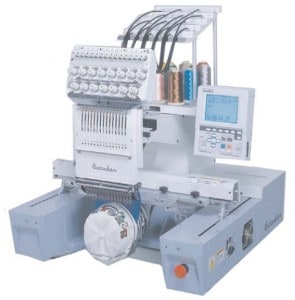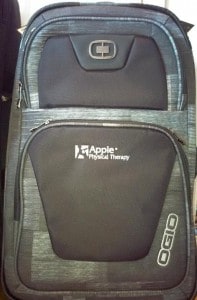We had an inquiry from a potential client in New York about embroidered luggage. This person asked why every shop he had contacted had said it could not be done while we have a blog post that talks about how it is possible to embroider luggage. He supplied the photo featured above.
Why this cannot be successfully accomplished is actually a two part question.
Q1. Is it even possible to embroider this luggage bag?
A1. It does not appear so. The ideal place to decorate this piece of luggage is on the flap where the manufacturer placed its own logo badge. Embroidering over the manufacturer’s logo badge is likely to have a bad result. In addition, decorating luggage presents challenges related to physical constraints. Below is an image of a typical commercial embroidery machine.

There is a lot to look at in that picture, but notice the volume of space where the hat is sitting. How big is that space? It’s about 19 inches wide, 15 inches deep, and about 5.5 inches tall (there’s a small shelf in there that juts out and potentially affects the available depth). So, what gets moved in order to achieve an embroidered cap as pictured? The whole face and top parts of the machine do move, but only for the purposes of selecting one needle and then moving that needle up and down through the garment at one single point in space. It is the cap that is being moved around in X and Y dimensions under the needle.
A hat is relatively small and moves very freely in that space, especially because the device onto which the cap is mounted spins and slides the cap under the needle in use. When we mount a shirt or jacket on the machine, it usually hangs from a hooping frame quite freely in that same space. Now imagine what is going to happen with the luggage bag pictured above.
The top flap of the bag could be viable, but that only works if the bag’s manufacturer hasn’t placed its own badge there.
To embroider on the lower section of the travel bag pictured above, the whole bag top would need to into that small space and not get knocked off of the machine while the bag is moved left, right, back, and forward. The space under the needles is not deep enough for the back and forth movement in any direction. The result will be an job interrupted by some sort of catastrophic failure. At best, a needle will be forcibly broken off in the middle of the job, which then causes the machine to grind to a halt with a sound that resembles car grinding its transmission gears. This is REALLY not a desired outcome!
So how is it possible to decorate luggage in the way we have done in the nearby photo ? The bags we sell and embroider for our clients were manufactured by our suppliers with decoration in mind. That is a crucial factor. Thought and testing goes into the design process about where a logo could be placed and how the bag can be successfully embroidered. Note that the pictured bag also has a manufacturer’s badge on the top flap. But what our OGIO bag supplier was clever enough to do is build a second pocket that unzips enough that the bag can still be held away from the confining space by the machine operator for the duration of the job (yes, held away by hand).
? The bags we sell and embroider for our clients were manufactured by our suppliers with decoration in mind. That is a crucial factor. Thought and testing goes into the design process about where a logo could be placed and how the bag can be successfully embroidered. Note that the pictured bag also has a manufacturer’s badge on the top flap. But what our OGIO bag supplier was clever enough to do is build a second pocket that unzips enough that the bag can still be held away from the confining space by the machine operator for the duration of the job (yes, held away by hand).
And that leads us to Q2….
Q2. WOULD any shop take this project on?
A2. Unlikely. Most shops do not want to do work on customer-supplied items. It is risky in multiple ways. Let me illustrate that with just a couple of questions:
1) If you wanted to bring your own bag into a shop, would you expect to pay more than $20-$40 to have a piece of luggage embroidered?
2) Given the difficulty and the risks described in the first section above, and given that one of every 50 items that goes onto an embroidery machine (industry-wide) will be damaged or destroyed for myriad reasons, and given the answer to the pricing expectation question I just posed above, is it good business for the shop owner to take this job?
The bottom line is that what simplifies an embroidery shop’s operation, reduces the shop’s risk, and improves the shop’s profitability is to offer quality travel bags and insist that customers choose from the bags the shop can provide — bags that the shop can purchase at wholesale pricing and bags that were designed with decoration in mind.


